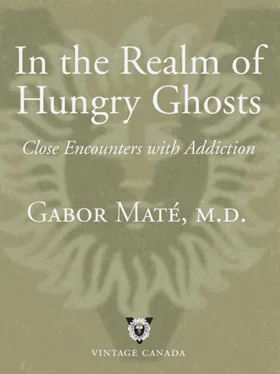Infants require more than the physical presence and attention of the parent. Just as the visual circuits need light waves for their development, the emotional centres of the infant brain, in particular the all-important orbitofrontal cortex (OFC), require healthy emotional input from the parenting adults. Infants read, react to and are developmentally influenced by the psychological states of the parents. They are affected by body language: tension in the arms that hold them, tone of voice, joyful or despondent facial expressions and, yes, the size of the pupils. In a very real sense, the parent’s brain programs the infant’s, and this is why stressed parents will often rear children whose stress apparatus also runs in high gear, no matter how much they love their child and no matter that they strive to do their best.
The electrical activity of the infant’s brain is exquisitely sensitive to that of the nurturing adult. A study at the University of Washington in Seattle compared the brainwave patterns of two groups of six-month-old infants: one group whose mothers were suffering post partum depression and one group whose mothers were in normal good spirits. Electroencephalograms, or EEGs, showed consistent, marked differences between the two groups: the babies of the depressed mothers had EEG patterns characteristic of depression even during interactions with their mothers that were meant to elicit a joyful response. Significantly, these effects were noted only in the frontal areas of the brain, where the centres for the self-regulation of emotion are located. 10How does this pertain to brain development? Repeatedly-firing nerve patterns become wired into the brain and will form part of a person’s habitual responses to the world. In the words of the great Canadian neuroscientist Donald Hebb, “cells that fire together, wire together.” The infants of stressed or depressed parents are likely to encode negative emotional patterns in their brains.
The long-term effect of parental mood on the biology of the child’s brain is illustrated by several studies showing that concentrations of the stress hormone cortisol are elevated in the children of clinically depressed mothers. At age three, the highest cortisol levels were found in those children whose mothers had been depressed during the child’s first year of life, rather than later. *17 11Thus we see that the brain is “experience-dependent.” Good experiences lead to healthy brain development, while the absence of good experiences or the presence of bad ones distorts development in essential brain structures. Dr. Rhawn Joseph, a scientist at the Brain Research Laboratory in San Jose, California, explains it this way:
[An] abnormal or impoverished rearing environment can decrease a thousand fold the number of synapses per axon [the long extension from the cell body that conducts electrical impulses toward another neuron], retard growth and eliminate billions if not trillions of synapses per brain, and result in the preservation of abnormal interconnections which are normally discarded over the course of development. 12
Since the brain governs mood, emotional self-control and social behaviour, we can expect that the neurological consequences of adverse experiences will lead to deficits in the personal and social lives of people who suffer them in childhood, including, Dr. Joseph continues, “a reduced ability to anticipate consequences or to inhibit irrelevant or inappropriate, self-destructive behaviors.”
Were these not exactly the dysfunctions we witnessed in Claire and Don in the previous chapter? It’s what we see in all hardcore drug addicts.
We know that the majority of chronically hardcore substance-dependent adults lived, as infants and children, under conditions of severe adversity that left an indelible stamp on their development. Their predisposition to addiction was programmed in their early years. Their brains never had a chance.
CHAPTER 18

Trauma, Stress and the Biology of Addiction
The idea that the environment shapes brain development is a very straightforward one, even if the details are immeasurably complex. Think of a kernel of wheat. No matter how genetically sound a seed may be, factors such as sunlight, soil quality and irrigation must act on it properly if it is to germinate and grow into a healthy adult plant. Two identical seeds, cultivated under opposing conditions, would yield two different plants: one tall, robust and fertile; the other stunted, wilted and unproductive. The second plant is not diseased: it only lacked the conditions required to reach its full potential. Moreover, if it does develop some sort of plant ailment in the course of its life, it would be easy to see how a deprived environment contributed to its weakness and susceptibility. The same principles apply to the human brain.
The three dominant brain systems in addiction—the opioid attachment-reward system, the dopamine-based incentive-motivation apparatus and the self-regulation areas of the prefrontal cortex—are all exquisitely fine-tuned by the environment. To various degrees, in all addicted persons these systems are out of kilter. The same is true, we will see, of the fourth brain-body system implicated in addiction: the stress-response mechanism.
Happy, attuned emotional interactions with parents stimulate a release of natural opioids in an infant’s brain. This endorphin surge promotes the attachment relationship and the further development of the child’s opioid and dopamine circuitry. 1On the other hand, stress reduces the numbers of both opiate and dopamine receptors. Healthy growth of these crucial systems—responsible for such essential drives as love, connection, pain relief, pleasure, incentive and motivation—depends, therefore, on the quality of the attachment relationship. When circumstances do not allow the infant and young child to experience consistently secure interactions or, worse, expose him to many painfully stressing ones, maldevelopment often results.
Dopamine levels in a baby’s brain fluctuate, depending on the presence or absence of the parent. In four-month-old monkeys major alterations of dopamine and other neurotransmitter systems were found after only six days of separation from their mothers. “In these experiments,” writes Dr. Steven Dubovsky, “loss of an important attachment appears to lead to less of an important neurotransmitter in the brain. Once these circuits stop functioning normally, it becomes more and more difficult to activate the mind.” 2
We know from animal studies that social-emotional stimulation is necessary for the growth of the nerve endings that release dopamine and for the growth of receptors to which dopamine needs to bind in order to do its work. Even adult rats and mice kept in long-term isolation will have a reduced number of dopamine receptors in the midbrain incentive circuits and, notably, in the frontal areas implicated in addiction. 3Rats separated from their mothers at an early stage display permanent disruption of the dopamine incentive-motivation system in their midbrains. As we already know, abnormalities in this system play a key role in the onset of addiction and craving. Predictably, in adulthood these maternally deprived animals exhibit a greater propensity to self-administer cocaine. 4And it doesn’t take extreme deprivation: in another study, rat pups deprived of their mother’s presence for only one hour a day during their first week of life grew up to be much more eager than their peers to take cocaine on their own. 5So the presence of consistent parental contact in infancy is one factor in the normal development of the brain’s neurotransmitter systems; the absence of it makes the child more vulnerable to “needing” drugs of abuse later on to supplement what her own brain is lacking. Another key factor is the quality of the contact the parent provides, and this, as we saw in the previous chapter, depends very much on the parent’s mood and stress level.
Читать дальше













